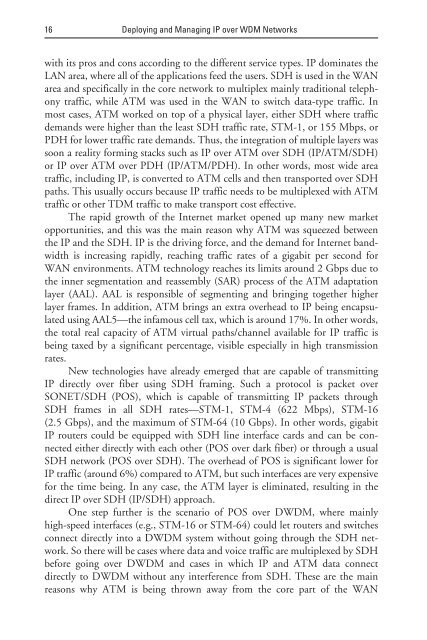deploying and managing ip over wdm networks - Index of
deploying and managing ip over wdm networks - Index of
deploying and managing ip over wdm networks - Index of
You also want an ePaper? Increase the reach of your titles
YUMPU automatically turns print PDFs into web optimized ePapers that Google loves.
16 Deploying <strong>and</strong> Managing IP <strong>over</strong> WDM Networks<br />
with its pros <strong>and</strong> cons according to the different service types. IP dominates the<br />
LAN area, where all <strong>of</strong> the applications feed the users. SDH is used in the WAN<br />
area <strong>and</strong> specifically in the core network to mult<strong>ip</strong>lex mainly traditional telephony<br />
traffic, while ATM was used in the WAN to switch data-type traffic. In<br />
most cases, ATM worked on top <strong>of</strong> a physical layer, either SDH where traffic<br />
dem<strong>and</strong>s were higher than the least SDH traffic rate, STM-1, or 155 Mbps, or<br />
PDH for lower traffic rate dem<strong>and</strong>s. Thus, the integration <strong>of</strong> mult<strong>ip</strong>le layers was<br />
soon a reality forming stacks such as IP <strong>over</strong> ATM <strong>over</strong> SDH (IP/ATM/SDH)<br />
or IP <strong>over</strong> ATM <strong>over</strong> PDH (IP/ATM/PDH). In other words, most wide area<br />
traffic, including IP, is converted to ATM cells <strong>and</strong> then transported <strong>over</strong> SDH<br />
paths. This usually occurs because IP traffic needs to be mult<strong>ip</strong>lexed with ATM<br />
traffic or other TDM traffic to make transport cost effective.<br />
The rapid growth <strong>of</strong> the Internet market opened up many new market<br />
opportunities, <strong>and</strong> this was the main reason why ATM was squeezed between<br />
the IP <strong>and</strong> the SDH. IP is the driving force, <strong>and</strong> the dem<strong>and</strong> for Internet b<strong>and</strong>width<br />
is increasing rapidly, reaching traffic rates <strong>of</strong> a gigabit per second for<br />
WAN environments. ATM technology reaches its limits around 2 Gbps due to<br />
the inner segmentation <strong>and</strong> reassembly (SAR) process <strong>of</strong> the ATM adaptation<br />
layer (AAL). AAL is responsible <strong>of</strong> segmenting <strong>and</strong> bringing together higher<br />
layer frames. In addition, ATM brings an extra <strong>over</strong>head to IP being encapsulated<br />
using AAL5—the infamous cell tax, which is around 17%. In other words,<br />
the total real capacity <strong>of</strong> ATM virtual paths/channel available for IP traffic is<br />
being taxed by a significant percentage, visible especially in high transmission<br />
rates.<br />
New technologies have already emerged that are capable <strong>of</strong> transmitting<br />
IP directly <strong>over</strong> fiber using SDH framing. Such a protocol is packet <strong>over</strong><br />
SONET/SDH (POS), which is capable <strong>of</strong> transmitting IP packets through<br />
SDH frames in all SDH rates—STM-1, STM-4 (622 Mbps), STM-16<br />
(2.5 Gbps), <strong>and</strong> the maximum <strong>of</strong> STM-64 (10 Gbps). In other words, gigabit<br />
IP routers could be equ<strong>ip</strong>ped with SDH line interface cards <strong>and</strong> can be connected<br />
either directly with each other (POS <strong>over</strong> dark fiber) or through a usual<br />
SDH network (POS <strong>over</strong> SDH). The <strong>over</strong>head <strong>of</strong> POS is significant lower for<br />
IP traffic (around 6%) compared to ATM, but such interfaces are very expensive<br />
for the time being. In any case, the ATM layer is eliminated, resulting in the<br />
direct IP <strong>over</strong> SDH (IP/SDH) approach.<br />
One step further is the scenario <strong>of</strong> POS <strong>over</strong> DWDM, where mainly<br />
high-speed interfaces (e.g., STM-16 or STM-64) could let routers <strong>and</strong> switches<br />
connect directly into a DWDM system without going through the SDH network.<br />
So there will be cases where data <strong>and</strong> voice traffic are mult<strong>ip</strong>lexed by SDH<br />
before going <strong>over</strong> DWDM <strong>and</strong> cases in which IP <strong>and</strong> ATM data connect<br />
directly to DWDM without any interference from SDH. These are the main<br />
reasons why ATM is being thrown away from the core part <strong>of</strong> the WAN


